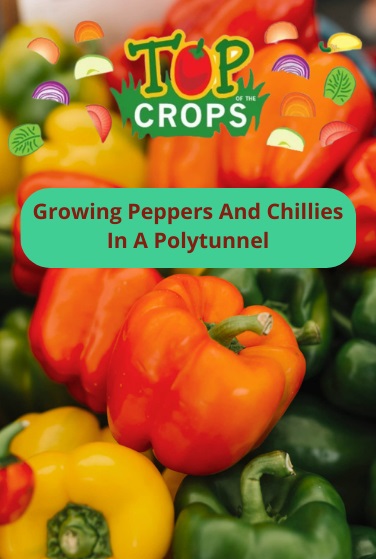Welcome to Top of the Crops! Today, you will learn how to grow peppers and chillies in a polytunnel in the UK. Prepare for a spicy guide full of insightful tips for amateur and professional gardeners. For more gardening advice, check out our huge blog Polytunnel Gardening.
Plenty of peppers are popular plants for polytunnel growers. Whether we are talking about sweet bell peppers, or fiery chillies, there are plenty of varieties to choose from.
| Jan | Feb | Mar | Apr | May | Jun | Jul | Aug | Sep | Oct | Nov | Dec | |
| Sow |  |
 |
 |
 |
||||||||
| Plant |  |
 |
||||||||||
| Harvest |  |
 |
 |
 |
Bell peppers and chilli peppers are both popular choices for polytunnel gardens. These plants in the Capsicum genus like the extra heat that a polytunnel can provide in summer, and tend to thrive in the more sheltered conditions a polytunnel can provide.
Peppers come in many colours, shapes, and sizes, and range from the mild and sweet to the 'blow your head off' spicy hot.
The intensity of the "heat" of chilli peppers is commonly reported in Scoville heat units (SHU). There are five domesticated species of peppers of which the most commonly cultivated is Capsicum annuum.
Peppers seeds can purchased at many garden centres and online. Selecting the peppers to suit your tastes and garden can be an interesting pursuit, and you can try out a range of interesting options.
Some garden centres also offer starter plants, or pot grown specimens, if you would prefer not to grow from seed.
To grow well, peppers need:
Full sun, and as warm and sheltered a position as possible. Usually this means growing undercover in a greenhouse, polytunnel or cold frame.
Temperatures above 12 degrees C. and ideally always above 15 degrees C.
A fertile, rich soil that is moist yet free draining and slightly acidic.
To grow peppers you will usually need:
Pepper seeds or starter plants.
A suitable growing location – usually somewhere undercover.
Seed trays/ pots/ soil blocks etc...
Heated propagator (optional but recommended for best germination results).
Gloves (for gardening, and for touching very hot peppers if these are grown).
Facility to water your pepper crop.
Organic matter such as compost or well-rotted manure for use as mulch.
A garden trowel for transplanting.
Growing peppers is largely a question of getting placement and timings right.
Pepper seeds should be sown early in the year, usually between late January and early April. If the peppers will grow on under glass or in a polytunnel, they will be sown towards the earlier end of this range – if they are to grow on outdoors for the summer then they are typically sown a little later.
Pepper seeds require quite high temperatures for successful germination rates. Temperatures should ideally be kept between 18 and 21 degrees. A heated propagator can make things easier, but the seeds should also germinate on a sunny windowsill with a clear cover to retain heat and moisture.
Once the seeds have sprouted, the seedlings should be removed from the propagator and kept in as bright a spot as possible where the temperatures are around 16-18 degrees C. and watered regularly.
When the pepper seedlings have developed a couple of true leaves, each one of the pepper seedlings should be pricked out and potted into their own individual pots, around 7.5-9cm in diameter.
They should be kept in a warm and bright spot until the weather has warmed sufficiently to place them into their final growing positions in late April, May or June. They can then be hardened off and planted out into polytunnel or greenhouse beds, or placed into their final containers, which should be at least 30-40cm in diameter.
In a heated greenhouse or heated polytunnel, peppers will be planted out in late April. In an unheated but protected space they will be planted or potted into their final container in around mid May.
You will need to wait until late May or June to plant outside – but remember that peppers will almost always fruit best in the UK undercover so results from outdoors grown peppers are often disappointing.
Companion plants are something else to consider when deciding where to plant out peppers and when doing so. Don't think about each of your crops in isolation. It is always best to make holistic plans for your garden to create a biodiverse, stable and resilient space.
Though growing peppers from seed is not particularly challenging, remember that you might also grow from container grown plants that you have purchased. Just remember that this is not the cheapest nor the most sustainable choice.
Meeting the environmental and care needs of peppers is important in order to obtain the best and highest yields.
Temperatures of between 12 and 30ºC. and ideally above 15ºC. are required for peppers to perform well in your garden. Peppers also like humid conditions and so taking steps like damping down on hot days can help peppers to thrive.
It is of course important to water consistently through the growing season – especially while pepper plants are flowering and fruiting. Make sure that you direct water to where it is needed, the soil or growing medium around the roots, and try not to wet the foliage.
Applying an organic mulch around your pepper plants when you plant them out can help to retain soil moisture. You can also add additional vegetative mulch (chopped and dropped) over the summer months for additional soil cover and nutrition. Choosing plant material rich in potassium can aid with successful fruiting of pepper plants.
In addition to mulching and ensuring a healthy soil, you can also ensure that the nutritional needs of pepper plants are met by feeding your plants with an organic, potassium-rich liquid plant feed every week or so once the plants start to flower, especially those growing in pots or other containers.
Once pepper plants are around 30cm in height, it is a good idea to pinch out the main growing tip. This encourages branching and bushiness and can increase yields. If it is desirable with the cultivar you are growing to have more but smaller fruits, side shoots can also be pinched back to encourage even more branching.
Pepper plants that are on the taller side and those that bear particularly large, heavy fruits may require staking or some other form of support as the season progresses. Tie branches in loosely to supports and be careful to avoid any breakages.
Peppers grown undercover can usually be harvested any time from mid summer to autumn. If grown outdoors, the season is typically a little shorter – starting later and finishing a little earlier.
Peppers vary greatly in their size and colour at maturity. Most peppers will go through different colours as they mature – many changing from green to red, but others that go through many different hues.
Some are best harvested while immature, to increase yields overall, while others are best left to develop their full flavour on the plant, even though this will hinder the development of more fruits.
It is important to do your research on the particular cultivar or cultivars that you are growing, so you know when to harvest that particular pepper crop.
There are many bell pepper recipes and of course there are also plenty of ways to use chilli peppers in your kitchen. Whichever peppers you have chosen to grow you are sure to be able to make good use of them.
Sweet peppers are best eaten fresh, soon after harvesting. They will store for a few days in your fridge. You can also use them in recipes which can then be frozen for later use. Chilli peppers can also be used fresh, or they can be dried for later use. Of course, peppers might also be used in a wide range of chutneys and other preserves that might be canned for longer-term storage.
Varieties of sweet pepper that are recommended for UK growers include this list of options that have received an award of garden merit from the RHS:
‘Amy’
‘Astor’
‘Beja’
‘Bianca’
‘Corno di Toro Giallo’
‘Corno di Toro Rosso’
‘Cuneo Giallo’
‘Diablo’
‘Friggitello’
‘Gourmet’
‘Hamík’
‘Jolly Giallo’
‘Mohawk’
‘Redskin’
‘Tarquinio’
‘Topepo Rosso’
Heritage pepper varieties also abound and are well worth considering.
Here are the chilli peppers with an award of garden merit from the RHS:
‘Apache’
‘Basket of Fire’
‘Bolivian Rainbow’
‘Caribbean Antillais’
‘Demon Red’
‘Etna’
‘Filius Blue’
‘Fresno’
‘Fuego’
‘Hot Thai’
‘Hungarian Hot Wax’
‘Krakatoa’
‘Loco’
‘Navaho’
‘Pot Black’
‘Prairie Fire’
‘Riot’
‘Super Chili’
‘Treasure's Red’
Look out for pests when growing pepper plants. Common issues include aphids, whitefly and other sap suckers, slugs and snails, and greenhouse pests like red spider mites, especially when the conditions are dry.
Remember, companion planting can help peppers by drawing in pollinators and predatory insects, and may sometimes help by repelling, confusing or distracting pest species. Add to the biodiversity in an organic garden to keep the ecosystem in balance.
If you have ever rubbed an eye after cutting chilli peppers then you will understand why you should wear gloves when handing very hot peppers. Not all peppers will be as fiery as the new hottest pepper, of course. But it is important to be careful.
Choosing the right peppers to grow can help you make the most of the space available in a polytunnel garden. There are smaller cultivars ideal for small spaces, containers and even hanging baskets.
Even in a polytunnel, peppers planted out in cooler regions may benefit from warmer soil. Warm the soil prior to planting with cloches, or plant into a hot bed with gentle heat from decomposing organic matter below.
Mulch peppers and other fruiting plants with comfrey leaves or other 'dynamic accumulator' plant materials to add potassium.
Rotate pepper crops – making sure that you do not grow peppers or its relatives (e.g tomatoes, aubergines etc...) in the same bed over multiple years.
Remember to companion plant with suitable neighbours to boost your yields of peppers and to keep your organic garden as healthy as possible.
When you grow peppers in your garden, remember that heat, sun and fertile conditions are key to getting as much as possible from your crop.
BBC News. (n.d.) Guinness World Records Crowns New Hottest Pepper. BBC News. [online] Available at: https://www.bbc.co.uk/news/world-us-canada-67136085 [accessed 15/12/23]
Filson, M., (2022) 25 Bell Pepper Recipes That Prove They Aren't Just for Stuffed Peppers. Delish. [online] Available at: https://www.delish.com/cooking/recipe-ideas/g40327395/bell-pepper-recipes/ [accessed 15/12/23]
